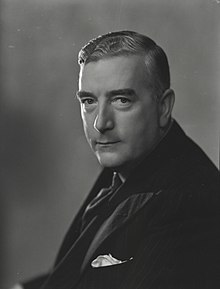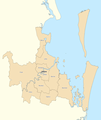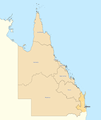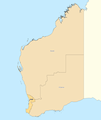Okręgi wyborcze do Izby Reprezentantów (Australia)
| AustraliaTen artykuł jest częścią serii: Ustrój i polityka Australii Ustrój polityczny Konstytucja Monarcha Władza ustawodawcza Władza wykonawcza Władza sądownicza Kontrola państwowa Finanse Samorząd terytorialny Partie polityczne Wybory Polityka zagraniczna Wikiprojekt Polityka |
Izba Reprezentantów Australii składa się ze 150 członków wybieranych na trzyletnią kadencję w jednomandatowych okręgach wyborczych z zastosowaniem proporcjonalnego wyboru (ordynacji preferencyjnej). W związku tym, obszar kraju podzielony jest na potrzeby wyborów do Izby na 150 okręgów.
Zasady ogólne
Granice okręgów wyborczych są poddawane weryfikacji nie rzadziej niż co siedem lat (czyli co nieco ponad dwie kadencje parlamentarne). Pierwszym etapem weryfikacji jest podział miejsc w Izbie między stany i terytoria, proporcjonalnie do ich ludności (specjalny status posiada Terytorium Północne, mające tyle samo miejsc co Australijskie Terytorium Stołeczne pomimo wyraźnie mniejszego zaludnienia). Następnie wewnątrz każdego stanu i terytorium wyrysowywane są granice okręgów. Kluczowym kryterium jest tutaj liczba zarejestrowanych wyborców na danym terenie (nie jest ona tożsama z ogólną liczbą mieszkańców). Prawo przewiduje, iż liczba wyborców w okręgu nie może różnić się o więcej niż 10% w żadną stronę od średniej dla danego stanu lub terytorium. Żadnego znaczenia nie ma natomiast powierzchnia okręgów, co sprawia, iż na najbardziej odludnych obszarach Australii, okręgi niekiedy osiągają powierzchnię rzędu setek tysięcy kilometrów kwadratowych.
Organem odpowiedzialnym za weryfikację granic okręgów jest Australijska Komisja Wyborcza, czuwająca również nad prawidłowym przebiegiem samych wyborów. Posiada ona także prawo likwidacji okręgów i tworzenia nowych (z zastrzeżeniem, iż ich łączna liczba musi odpowiadać liczbie miejsc w Izbie).
Nazewnictwo
Australia stosuje dość unikatowy sposób nazywania jednomandatowych okręgów wyborczych. W większości krajów stosujących tego typu jednostki, są one numerowane (jak np. w USA) lub czerpią nazwy od obiektów geograficznych, zwłaszcza miast (jak np. w Wielkiej Brytanii). W przypadków okręgów do australijskiej Izby Reprezentantów stosuje się następujące wytyczne:
- Co do zasady, okręgi powinny być nazywane od nazwisk zmarłych Australijczyków, wyjątkowo zasłużonych dla ojczyzny. Pierwszeństwo w tej kategorii powinni mieć byli premierzy.
- Należy dbać o zachowanie w użyciu nazw 75 pierwotnych okręgów wyborczych, ustanowionych zaraz po powstaniu Związku Australijskiego w 1901 roku.
- Należy unikać nazw geograficznych, choć dopuszczalne są wyjątki od tej zasady.
- Tam gdzie to możliwe, należy stosować nazwy aborygeńskie.
- Nie należy dublować nazw istniejących już okręgów zarówno do parlamentu federalnego, jak i parlamentów stanowych[1].
Lista okręgów
W rubryce „patron” podano osobę lub obiekt geograficzny, od której dany okręg czerpie nazwę.
Nowa Południowa Walia


Nowa Południowa Walia jako najludniejszy stan Australii dysponuje 47 miejscami w Izbie Reprezentantów i tyle też okręgów wyborczych znajduje się na jej obszarze.
| Okręg | Patron |
|---|---|
| Banks | Joseph Banks |
| Barton | Edmund Barton |
| Bennelong | Bennelong |
| Berowra | Berowra |
| Blaxland | Gregory Blaxland |
| Bradfield | John Bradfield |
| Calare | Lachlan[2] |
| Chifley | Ben Chifley |
| Cook | James Cook |
| Cowper | Charles Cowper |
| Cunningham | Allan Cunningham |
| Dobell | William Dobell |
| Eden-Monaro | Eden, Monaro |
| Farrer | William Farrer |
| Fowler | Lilian Fowler |
| Gilmore | Mary Gilmore |
| Grayndler | Edward Grayndler |
| Greenway | Francis Greenway |
| Hughes | Billy Hughes |
| Hume | Hamilton Hume |
| Hunter | John Hunter |
| Kingsford Smith | Charles Kingsford Smith |
| Lindsay | Norman Lindsay |
| Lyne | William Lyne |
| Macarthur | John i Elisabeth Macarthur |
| Mackellar | Dorothea Mackellar |
| Macquarie | Lachlan Macquarie |
| McMahon | William McMahon |
| Mitchell | Thomas Mitchell |
| New England | Nowa Anglia |
| Newcastle | Newcastle |
| North Sydney | North Sydney |
| Page | Earle Page |
| Parkes | Henry Parkes |
| Parramatta | Parramatta |
| Paterson | Banjo Paterson |
| Reid | George Reid |
| Richmond | Richmond |
| Riverina | Riverina |
| Robertson | John Robertson |
| Shortland | John Shortland |
| Sydney | Sydney |
| Warringah | Warringah |
| Watson | Chris Watson |
| Wentworth | William Wentworth |
| Werriwa | Lake George[3] |
| Whitlam | Gough Whitlam |
Wiktoria

W stanie Wiktoria wybieranych jest 37 deputowanych.
| Okręg | Patron |
|---|---|
| Aston | Tilly Aston |
| Ballarat | Ballarat |
| Batman | John Batman |
| Bendigo | Bendigo |
| Bruce | Stanley Bruce |
| Calwell | Arthur Calwell |
| Casey | Richard Casey |
| Chisholm | Caroline Chisholm |
| Corangamite | Jezioro Corangamite |
| Corio | Zatoka Corio |
| Deakin | Alfred Deakin |
| Dunkley | Louisa Dunkley |
| Flinders | Matthew Flinders |
| Gellibrand | Joseph Gellibrand |
| Gippsland | Gippsland |
| Goldstein | Vida Goldstein |
| Gorton | John Gorton |
| Higgins | H.B. Higgins |
| Holt | Harold Holt |
| Hotham | Charles Hotham |
| Indi | rzeka Murray[4] |
| Isaacs | Isaac Isaacs |
| Jagajaga | Jagajaga |
| Kooyong | Kooyong |
| Lalor | Peter Lalor |
| La Trobe | Charles La Trobe |
| McEwen | John McEwen |
| McMillan | Angus McMillan |
| Mallee | The Mallee |
| Maribyrnong | Maribyrnong |
| Melbourne | Melbourne |
| Melbourne Ports | Port Melbourne |
| Menzies | Robert Menzies |
| Murray | Rzeka Murray |
| Scullin | James Scullin |
| Wannon | Wannon |
| Wills | William Wills |
Queensland
Stan Queensland ma w Izbie Reprezentantów 30 miejsc.
| Okręg | Patron |
|---|---|
| Blair | Harold Blair |
| Bonner | Neville Bonner |
| Bowman | David Bowman |
| Brisbane | Brisbane |
| Capricornia | zwrotnik Koziorożca |
| Dawson | Anderson Dawson |
| Dickson | James Dickson |
| Fadden | Arthur Fadden |
| Fairfax | Ruth Fairfax |
| Fisher | Andrew Fisher |
| Flynn | John Flynn |
| Forde | Frank Forde |
| Griffith | Samuel Griffith |
| Groom | Littleton Groom |
| Herbert | Robert Herbert |
| Hinkler | Bert Hinkler |
| Kennedy | Edmund Kennedy |
| Leichhardt | Ludwig Leichhardt |
| Lilley | Charles Lilley |
| Longman | Irene Longman |
| Maranoa | Rzeka Maranoa |
| McPherson | Góry McPhersona |
| Moncrieff | Gladys Moncrieff |
| Moreton | Zatoka Moreton |
| Oxley | John Oxley |
| Petrie | Andrew Petrie |
| Rankin | Annabelle Rankin |
| Ryan | T.J. Ryan |
| Wide Bay | Wide Bay |
| Wright | Judith Wright |
Australia Zachodnia
W stanie Australia Zachodnia wybieranych jest 15 członków Izby.
| Okręg | Patron |
|---|---|
| Brand | David Brand |
| Canning | Alfred Canning |
| Cowan | Edith Cowan |
| Curtin | John Curtin |
| Forrest | John Forrest |
| Fremantle | Fremantle |
| Hasluck | Paul Hasluck i Alexandra Hasluck |
| Duruck | rodzina Duruck |
| Moore | George Fletcher Moore |
| O’Connor | Charles O’Connor |
| Pearce | George Pearce |
| Perth | Perth |
| Stirling | James Stirling |
| Swan | Rzeka Łabędzia |
| Tangney | Dorothy Tangney |
Australia Południowa
Australia Południowa wystawia 11 reprezentantów.
| Okręg | Patron |
|---|---|
| Adelaide | Adelaide |
| Barker | Collet Barker |
| Boothby | William Boothby |
| Grey | George Grey |
| Hindmarsh | John Hindmarsh |
| Kingston | Charles Kingston |
| Makin | Norman Makin |
| Mayo | Helen Mayo |
| Port Adelaide | Port Adelaide |
| Sturt | Charles Sturt |
| Wakefield | Edward Gibbon Wakefield |
Tasmania
Tasmania dysponuje pięcioma miejscami w Izbie.
| Okręg | Patron |
|---|---|
| Bass | George Bass |
| Braddon | Edward Braddon |
| Denison | William Denison |
| Franklin | John Franklin |
| Lyons | Joseph Lyons |
Australijskie Terytorium Stołeczne
Mieszkańcy Australijskiego Terytorium Stołecznego wybierają dwóch członków Izby, która zbiera się na tym terytorium.
| Okręg | Patron |
|---|---|
| Canberra | Canberra |
| Fraser[5] | James Fraser |
Terytorium Północne
W Terytorium Północnym wybieranych jest dwóch członków Izby.
| Okręg | Patron |
|---|---|
| Lingiari[6] | Vincent Lingiari |
| Solomon | Vaiben Solomon |
Mapy
Wszystkie poniższe mapy pokazują podział Australii na federalne okręgi wyborcze, według stanu z dnia wyborów w 2010 roku.
Przypisy
- ↑ Guidline for Naming Divisions, wytyczne Australijskiej Komisji Wyborczej.
- ↑ Calare jest aborygeńską nazwą rzeki Lachlan.
- ↑ „Werriwa” to nazwa aborygeńska jeziora Lake George.
- ↑ Indi jest aborygeńską nazwą rzeki Murray.
- ↑ Okręg obejmuje również całość Terytorium Jervis Bay.
- ↑ Okręg obejmuje także Wyspę Bożego Narodzenia i Wyspy Kokosowe.
Media użyte na tej stronie
Commonwealth Coat of Arms of Australia granted by Royal Warrant signed by King George V on 19 September 1912.
IMPORTANT:This image is an artist's interpretation of the original (1912) official version of the Commonwealth Coat of Arms shown in Commons on the Australian coat of arms page. A variant of the original, with a transparent background, is shown on this page.
| “ | Quarterly of six, the first quarter Argent a Cross Gules charged with a Lion passant guardant between on each limb a Mullet of eight points Or; the second Azure five Mullets, one of eight, two of seven, one of six and one of five points of the first (representing the Constellation of the Southern Cross) ensigned with an Imperial Crown proper; the third of the first a Maltese Cross of the fourth, surmounted by a like Imperial Crown; the fourth of the third, on a Perch wreathed Vert and Gules an Australian Piping Shrike displayed also proper; the fifth also Or a Swan naiant to the sinister Sable; the last of the first, a Lion passant of the second, the whole within a Bordure Ermine; for the Crest on a Wreath Or and Azure A Seven-pointed Star Or, and for Supporters dexter a Kangaroo, sinister an Emu, both proper. | ” |
Autor: Barrylb, Licencja: CC BY-SA 3.0
This image incorporates data that is: © Commonwealth of Australia (Australian Electoral Commission) 2009
Tasmania divisions overview 2010Autor: Barrylb, Licencja: CC BY-SA 3.0
This image incorporates data that is: © Commonwealth of Australia (Australian Electoral Commission) 2009
Outside Perth divisions overview 2010Autor: Barrylb, Licencja: CC BY-SA 3.0
This image incorporates data that is: © Commonwealth of Australia (Australian Electoral Commission) 2009
Outside Brisbane divisions overview 2010Autor: Barrylb, Licencja: CC BY-SA 3.0
This image incorporates data that is: © Commonwealth of Australia (Australian Electoral Commission) 2009
Division of Solomon 2010Autor: Barrylb, Licencja: CC BY-SA 3.0
This image incorporates data that is: © Commonwealth of Australia (Australian Electoral Commission) 2009
Melbourne divisions overview 2010Dorothea Mackellar, Australian poet
- Information - Portrait of Robert Gordon Menzies, former en:Prime Minister of Australia, taken by Luke Monte (1885-1962).
- Source - National Library of Australia
- Copyright Information - picture was taken in the 1930s - for photographs taken prior to 2005, Australian copyright expires 50 years after the photograph was taken. This photo is in the public domain.
- License:
Autor: Barrylb, Licencja: CC BY-SA 3.0
This image incorporates data that is: © Commonwealth of Australia (Australian Electoral Commission) 2009
Rest of Queensland divisions overview 2010Autor: Barrylb, Licencja: CC BY-SA 3.0
This image incorporates data that is: © Commonwealth of Australia (Australian Electoral Commission) 2009
Division of Lingiari 2010Autor: Barrylb, Licencja: CC BY-SA 3.0
This image incorporates data that is: © Commonwealth of Australia (Australian Electoral Commission) 2009
Rest of Western Australia divisions overview 2010Autor: Barrylb, Licencja: CC BY-SA 3.0
This image incorporates data that is: © Commonwealth of Australia (Australian Electoral Commission) 2009
Brisbane divisions overview 2010Autor: Barrylb, Licencja: CC BY-SA 3.0
This image incorporates data that is: © Commonwealth of Australia (Australian Electoral Commission) 2009
Adelaide divisions overview 2010Autor: Barrylb, Licencja: CC BY-SA 3.0
This image incorporates data that is: © Commonwealth of Australia (Australian Electoral Commission) 2009
Rest of New South Wales divisions overview 2010Autor: Barrylb, Licencja: CC BY-SA 3.0
This image incorporates data that is: © Commonwealth of Australia (Australian Electoral Commission) 2009
Outside Melbourne divisions overview 2010Autor: Barrylb, Licencja: CC BY-SA 3.0
This image incorporates data that is: © Commonwealth of Australia (Australian Electoral Commission) 2009
Perth divisions overview 2010Autor: Barrylb, Licencja: CC BY-SA 3.0
This image incorporates data that is: © Commonwealth of Australia (Australian Electoral Commission) 2009
Rest of South Australia divisions overview 2010Autor: Barrylb, Licencja: CC BY-SA 3.0
This image incorporates data that is: © Commonwealth of Australia (Australian Electoral Commission) 2009
Rest of Victoria divisions overview 2010Autor: Barrylb, Licencja: CC BY-SA 3.0
This image incorporates data that is: © Commonwealth of Australia (Australian Electoral Commission) 2009
Outside Sydney divisions overview 2010Autor: Barrylb, Licencja: CC BY-SA 3.0
This image incorporates data that is: © Commonwealth of Australia (Australian Electoral Commission) 2009
Australian Capital Territory divisions overview 2010Autor: Barrylb, Licencja: CC BY-SA 3.0
This image incorporates data that is: © Commonwealth of Australia (Australian Electoral Commission) 2009
Sydney divisions overview 2010
Top to bottom, left to right:
- Lindsay; Chifley; Greenway; Mitchell; Bradfield; Mackellar
- Parramatta; Bennelong; North Sydney; Warringah
- McMahon; Reid; Sydney [city within the Sydney division]
- Fowler; Blaxland; Watson; Grayndler; Sydney; Wentworth
- Werriwa; Hughes; Banks; Barton; Kingsford Smith
- Cook








































